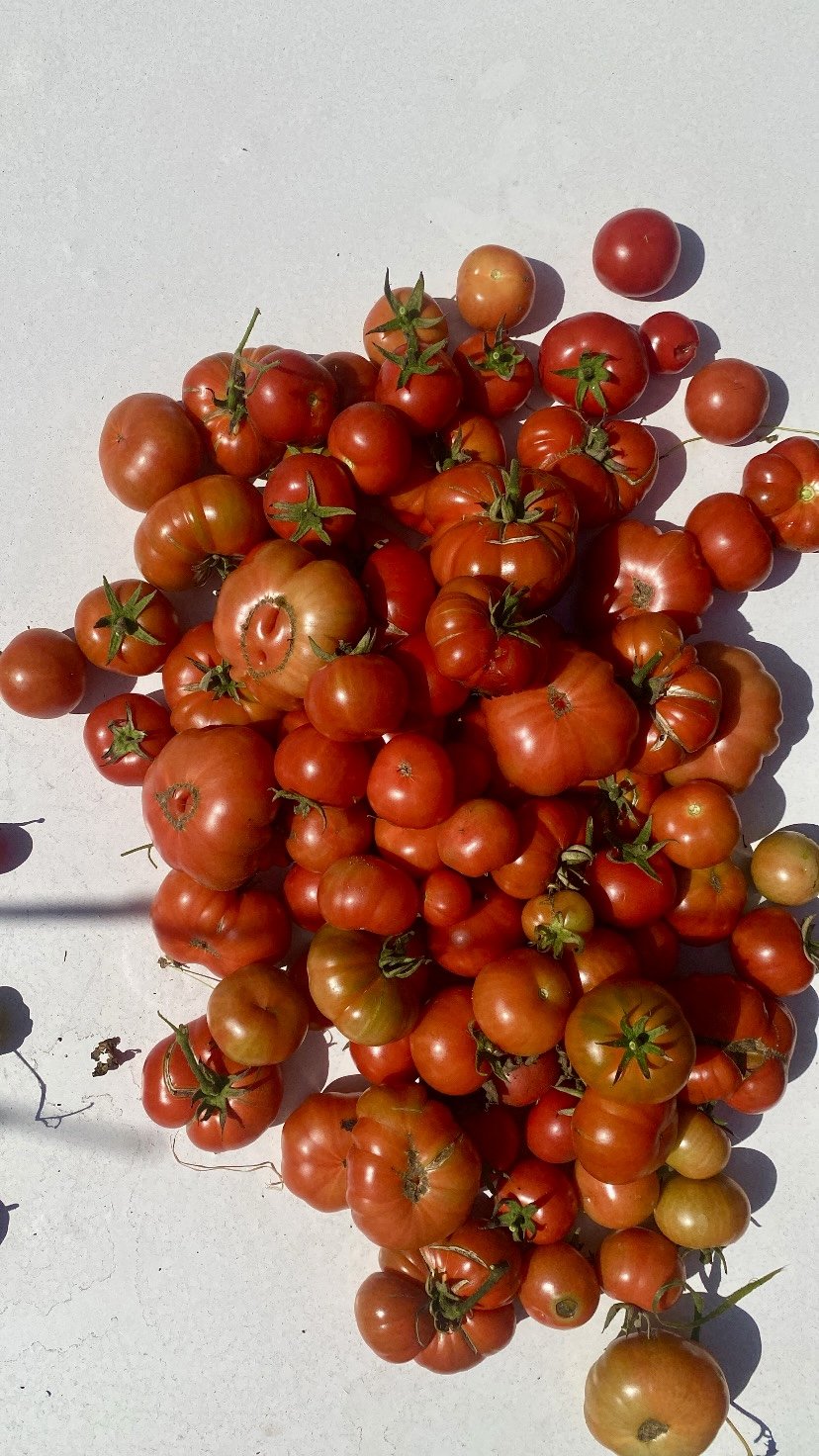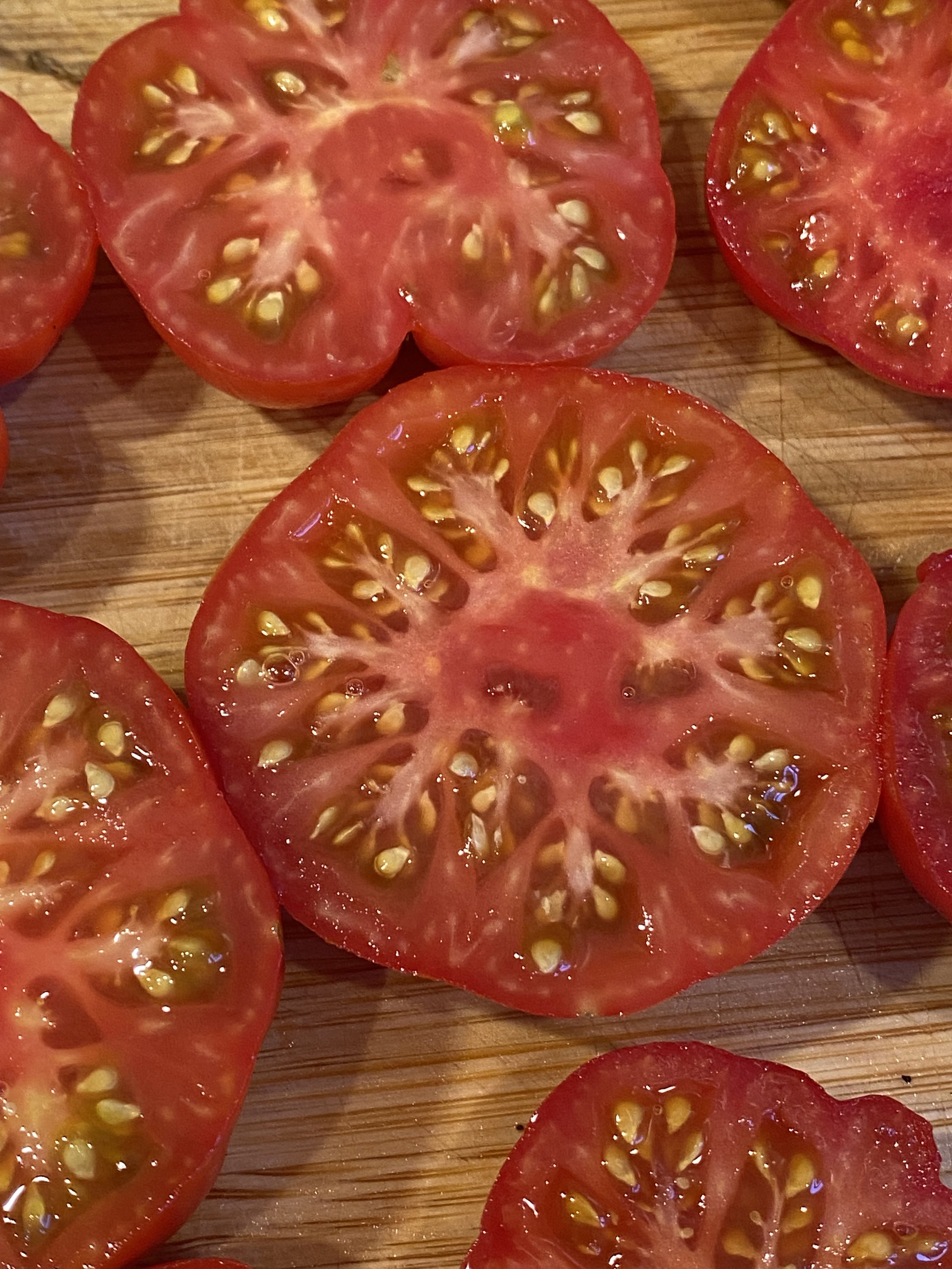
Gojeh Farangi Gilani “Pilamar” - Reyhan Herb Farm
Those who have been to Shomal (meaning North, the colloquial name given to Northern Iran), would not be surprised when Maryam calls it “the green part of Iran.” Gilan, the region where Maryam comes from, is indeed quite green, due to its proximity to the Caspian Sea. Its climate is characterized by warm, humid summers and cold, snowy winters. Maryam’s seeds came from her grandmother’s garden in Gilan. This beloved grandmother recently passed away, but she was known in her family and community as a wonderful gardener and seed saver. She is still fiercely praised for her brilliant taste, and her impeccable organization skills. Her children have since taken on growing many of her varieties, carrying her legacy forward.
One of her varieties is this beautiful tomato. While we don’t know exactly what this grandmother, who I’ll call Pilamar (meaning “grandmother’ in Gilaki), was selecting for when she saved seeds from her tomatoes every year, we do know about the types of dishes tomatoes are often used for in Gilan. One iconic dish is Mirza Gassemi, a dish that features eggs, fire-roasted and smokey eggplant, and the acidic punch of tomato. Gilan is, after all, known for its sour palate.
This year, the Pilamar tomato was grown at Reyhan Herb Farm, and also by a community member in Albany, CA through the Hayati program. Below is her experience growing the crop:
Late spring last year, the Flower Moon was coming into bloom and the planets Venus and Jupiter were coming together in the sky. I had tracked this moment of the year as astrologers told me to be aware and say yes to said windfall of grant money that was sure to come through. I hadn’t applied for any grants; I don’t think money was what my heart was hungry for. I contacted Sama because I heard about their garden project, and at first meeting I was handed a coin envelope with a cluster of tomato seeds stuck together. These were seeds that belonged to the grandmother of a woman named Maryam, they were saved from her garden in Iran. Sama and I scattered the seeds into a flat of soil that Sama had prepared in their backyard, and misted them with the ‘mister’ setting on the hose head a few times (fast), then left them to rest in the greenhouse. I had never grown from seed before and I was a little nervous. Always I had purchased starts from nurseries, leaving the process of growing from seed to some mystical nurturance concealed behind the fogged glass of a greenhouse. Sama had encouraged me to sprinkle the seeds semi-spaciously but we weren't overly particular about spacing or quantity. I was comforted by Sama’s coolness and casualness, a hint that bringing food to life was not inordinately precious. I was a little bewildered that these were seeds that someone had saved, had brought over from Iran, also a home ( the land ) that my bones longed for a connection with. These seeds to me were like a messenger between worlds, unburying a potential I had tucked away in a cold part of my psyche.
And so the seeds began to germinate, When the green shoots were about the length of half my thumb, we transferred them to individual containers to make starts. We prepared small containers with holes at the bottom and filled them just over halfway with soil. One by one we pulled out individual shoot-clusters and shimmied off the soil from the delicate roots. This movement was more tender. For this, you might imagine picking up a delicate piece of jewelry and placing it back down gently. We lightly placed the roots into a divet in the soil in each container. We lightly packed the soil up to the bottom of the shoot cluster, creating some support at the stem. Wide-eyed, we realized we had about eighty starts. I took only fourteen and Sama gifted and planted the rest.
Next came preparing the beds. It must have been June. To be honest, I was distracted. Joel and I were well underway with plans for getting married in Atlanta later in the summer, and we were anticipating a full sofreh aghd, one hundred degree temperatures, and tears of love and grief, probably . “We need a good wedding” my friend Ellie had said. Joel and I were in a crucible of pre-marital charge and confrontation. Often, tense and silent stillnesses were broken by my words: “and we need to prepare the garden boxes.” We purchased the boxes on a credit card and built them with emotional fits and starts. I called American Rock and Soil, and within days a mound of soil was in our driveway. In a heroic effort, Joel wheel-barrowed and shoveled the soil into the three large boxes at the center of our yard before I got home from work.
Note here: we could have placed the tomatoes straight in the ground but we knew we were throwing a huge party in the fall and had dogs, so garden boxes were the right move for us. Planting in the ground would have been like 80% more chill.
On a Monday night (at twilight) mid-June, we transplanted the starts. Monday evenings and the first hour of twilight are ruled by Venus. This moment was very easy and we tucked the little tomato plants into the soil divots and made sure to plant them slightly deep again so the stem would have support as the plants got heavy with tomatoes. Looking back, the plants looked sheepish in so much soil. I didn’t know yet the vines would be pooling over the edges soon. In retrospect, this would have been a good time to add some structure like tomato coils or something.
Joel took over watering the tomatoes. Every fourth day when he got home from teaching he’d water them, the dogs swirling around him like little fish in a pond. I sat and watched, studied the shape of the leaves, instagrammed their slight growth. Gave updates on the tomatoes to my family. Like the tomatoes were a shade and cover to hide from the eager and prying eyes of others, pre-wedding. Sometimes I’d get calls - “how are you feeling about everything?” and I would talk about the tomatoes, the scent of the leaves, how space and time can bend with a little bagh-e Irooni in my backyard.
We were married in Atlanta and Joel’s vows promised tomatoes. Our officiant celebrated tomatoes and the love and life in them. Tomatoes and their image were on our minds as we exchanged fingertips dipped in honey, and sealed our love with a kiss. Tomatoes are the opposite of grief and their name belonged at our altar.
It was several months before the tomatoes produced. Before they appeared there were yellow flowers, and lots of butterflies and bees buzzing about. I went to my friend Eva’s house and she helped me cut bamboo, from which we made homemade trellises. Then around September the tomatoes accumulated in green bulbs strung about, some round and some wide, with little stretch marks on their bottoms. Staying green they accumulated and accumulated. Then they all ripened at once. Sama says this is called “determinate” because they all come out at once.
Their flavor was bright, sour, citrusy. Their texture was fresh and glossy. We ate them on everything, and shared them with friends and family. We had so many, we gave them to a restaurant for free. I watched them glimmer in the sun on the vine. The dogs encircled them like on a race track of glee. We made a ton of tomato sauce. We threw a post-nuptial bash in the garden and used tomatoes in a large, forty-person paella. I was filled with a most basic pride.
For me, the best way to eat the tomatoes was on toasted sangak with briney feta.. I ate this day after day when I heard my grandmother had gotten sick. She was in a rapid descent with pneumonia, and my mom had now flown to Atlanta to care for her there. For weeks I ate tomato, bread and cheese while my heart was in a deep stream of aching. In October, I flew to Atlanta to say goodbye, my grandmother was in hospice at her home. I brought stacked containers of tomatoes, their little orbs tucked in side by side in plastic tupperware. After another month my grandmother emerged out of hospice. Now, thank god, she’s back to cracking jokes and playing card games. Everyone is saying the many relatives and the love that moved towards her saved her.
To save the tomato seeds, we took one tomato from each of our fourteen plants. We cut the tomatoes in half down the center from its side, kind of like cutting a biscuit in half to make a sandwich. We scooped out seeds and their fluid into a clean jar. You can eat the remaining tomato skins raw or toss them in a gazpacho. I roasted them with salt on low at 200 degrees for not long, although they mostly stuck to the pan. What I scraped up became a yummy tomato jam I mixed into sauteed chickpeas. Back to seed-saving, let the seeds and their fluids sit on the counter uncovered for about 48 to 72 hours. You will start to see the seeds sink as pulpy fluid rises and kind of foams at the top. They are lacto-fermenting, which breaks down the glossy casing on the outside of the seed, allowing them to more easily germinate in the future. To take out seeds, add a bit of water to the jar, swirl, and tip out the pulpy tomato-tissue from the top. Do this a couple of times, and it’s okay if some seeds are lost. Dry out the remaining seeds on a tea cloth by a window. When dry, store them in a jar for next year.
Right now, it is winter and there are still tomatoes coming out. They are multicolored and feral-looking, expressing some unexpected perennial power. I am continuing to save seeds and will see if they survive to spring. The tomatoes continue to be both food and symbol, the language for what I have trouble saying sometimes. Their taking shape in my life has been so simple, delicious, mundane and transformative.
- Aida

Stunning pattern in sliced tomato

